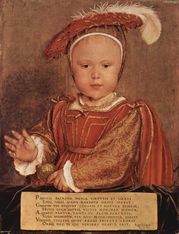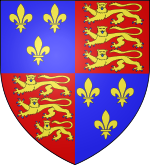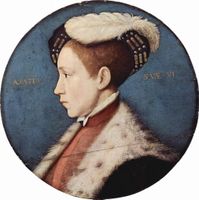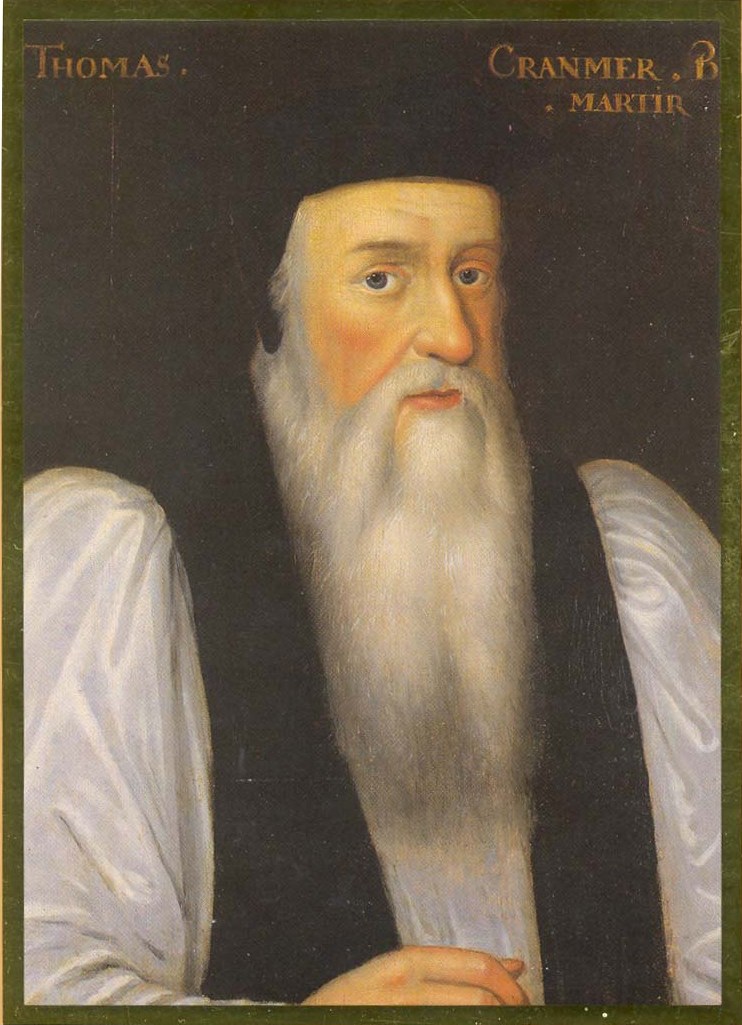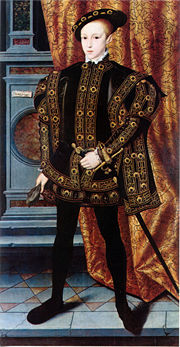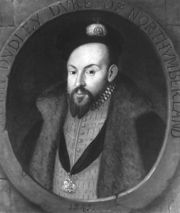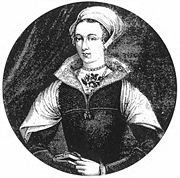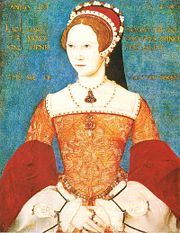Edward VI of England
2008/9 Schools Wikipedia Selection. Related subjects: British History 1500-1750; Monarchs of Great Britain
| Edward VI | |
|---|---|
| King of England and Ireland (more...) | |
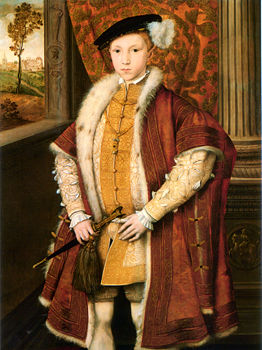 |
|
| Edward as Prince of Wales, Flemish School | |
| Reign | 28 January 1547 – 6 July 1553 |
| Coronation | 20 February 1547 |
| Predecessor | Henry VIII |
| Regent | Lord Northumberland (1549–1553) Lord Somerset (1547–1549) and Council |
| Successor | Jane |
|
Detail Titles and styles |
|
| HM The King The Prince of Wales The Duke of Cornwall |
|
| Royal house | House of Tudor |
| Father | Henry VIII |
| Mother | Jane Seymour |
| Born | 12 October 1537 Hampton Court Palace, Richmond upon Thames |
| Died | 6 July 1553 (aged 15) Palace of Placentia, Greenwich |
| Burial | 9 August 1553 Henry VII Lady Chapel, Westminster Abbey |
Edward VI ( 12 October 1537 – 6 July 1553) became King of England, King of France (in practice only the town and surrounding district of Calais) and Edward I of Ireland on 28 January 1547, and was crowned on 20 February, at nine years of age. Edward, the son of Henry VIII and Jane Seymour, was the third monarch of the Tudor dynasty and England's first ruler who was Protestant at the time of his ascension to the throne. Edward's entire rule was mediated through a council of regency as he never reached maturity. The council was first led by his uncle, Edward Seymour, 1st Duke of Somerset (1547–1549), and then by John Dudley, 1st Duke of Northumberland (1549–1553).
Although Henry VIII had severed the link between the English church and Rome, it was during Edward's reign that Protestantism was established for the first time in England, with Thomas Cranmer, the Archbishop of Canterbury, implementing the Book of Common Prayer. Edward's reign was marked by increasingly harsh Protestant reforms, the loss of control of Scotland, and an economic downturn. A period of social unrest begun earlier intensified during his rule, and conflicts with the French increased.
When it became clear that Edward's life was to be a short one, the Device to Alter the Succession was drafted to exclude his two half sisters, the devout Catholic Mary and moderate Protestant Elizabeth, from the line of succession to the throne in order to put Lady Jane Grey, his solidly Protestant cousin, great-granddaughter of Henry VII, next in line to succeed the king. Following Edward's death at the age of fifteen, a disputed succession reopened the religious conflicts. Lady Jane was Queen for only nine days, and during that time reigning in name only, before she was replaced by Mary. Queen Mary then sought to undo many of Edward's Protestant reforms with the Marian Repeal Acts in her first two Parliaments.
Early life
Edward was born at Hampton Court Palace in the London Borough of Richmond upon Thames. He was the son of King Henry VIII by his third wife, Jane Seymour, who died twelve days afterwards from puerperal fever. It is sometimes asserted that Jane sacrificed her life by the performance of a Caesarean section, but such assertions are without basis. Henry was deeply upset at Jane's death. He described Jane as his only ‘True Wife’ as she was the only one that provided him with the son he so desperately wanted.
Edward automatically became Duke of Cornwall upon his birth; a few days later he was created Prince of Wales. His early care was guided by his father, who specified nurses for him, foremost among them was the "Lady Mistress," Lady Bryan.
Henry VIII was extremely pleased by the birth of a male heir. He had disposed of his two previous wives, Catherine of Aragon (mother of Mary) and Anne Boleyn (mother of Elizabeth), partially because of their failure to produce male heirs. Both marriages were annulled: Anne Boleyn was executed, and Mary and Elizabeth were deemed illegitimate. Despite their illegitimacy, however, they were reinserted into the line of succession after Edward VI in 1544.
|
||||||||||
Until recently it was widely accepted that Edward VI was an extremely sickly child, but now evidence is coming to light showing him as much more robust. Theories have speculated that he suffered from congenital syphilis or from tuberculosis. His first illness, experienced at the age of 4, was a "quartan fever" which lasted for months. His supposed frailty may have led Henry VIII to quickly seek to remarry; the King's last three marriages ( Anne of Cleves, Catherine Howard, and Catherine Parr), however, did not produce any children. Other than this, he appears to have recovered quickly from other diseases. Edward's own journals mention no illness at all apart from a bout of measles in 1552. The policies of the Duke of Northumberland also indicate that he was making a foundation on which Edward was expected to build when he reached his maturity at sixteen, rather than expecting Edward to die young.
Edward's supposed physical difficulties did not impede his education; on the contrary, the young prince was a very bright child, already able to read and speak Greek and Latin at the age of seven. His principal tutors were Bishop Richard Cox, Sir John Cheke and Jean Belmain. These were able teachers and great minds at the time and imparted in Edward his knowledge of the Classics, seemingly based on the course of instruction described by Erasmus and Vives. Importantly, Henry VIII chose his tutors because they were humanists: he may also have considered their moderate Protestantism when making his choice, as Edward was not brought up in the Catholic religion. Edward's education was coloured by the Reformation that had swept through the Netherlands and Germany. He later learned to speak French and Greek, and, by the age of thirteen, he was writing essays in the latter language. He was quite fond of his stepmother Catherine Parr, and wrote three letters to her, one each in French, English and Latin. The rest of the letters he wrote were in Latin to his older sisters, Mary and Elizabeth, whom he addressed as his "Sweet Sister Temperance". (Waller, p. 47) Edward also had strong feelings for Mary, although these were tempered by their disagreements over religion. His love of learning and writing led him to found many grammar schools that were named after him. He also gave the Royal Charter to Sherborne School, which has a claim to be the oldest educational establishment in England, teaching having occurred in the Abbey, which forms part of the school, from the eighth century.
Christ's Hospital was the result of the vision of King Edward VI, assisted by Nicholas Ridley, Bishop of London, and Sir Richard Dobbs, Lord Mayor of London. Its genesis was the earlier dissolution of the monasteries and the resultant overflow onto the streets of the poor and destitute. Encouraged by a sermon from Ridley, exhorting mercy to the poor, the King wrote to the Lord Mayor encouraging him to action. This he did via a committee of 30 merchants. Henry VIII had already granted the use of Greyfriars to the City for the relief of the poor and Edward granted The Palace of Bridewell, his lands of the Savoy and rents and other chattels to create three Royal Hospitals — Bridewell Hospital (now the King Edward's School, Witley, Surrey), St Thomas Hospital and Christ's Hospital, which was for the education of poor children.
The first boys and girls entered the school in Newgate in 1552. The Royal Charter was granted and signed by its Founder, Edward VI, the following year, just a few days before his death.
Somerset's Protectorate
Council of Regency
Henry VIII died on 28 January 1547, when Edward was only 9. His will named sixteen executors, who were to act as a Council of Regency until Edward VI achieved majority at the age of eighteen (although it was agreed by the Council in 1552 that Edward would reach his majority at 16). These executors were to be supplemented by twelve assistants, who would participate only when the others deemed it fit. The executors were all inclined towards religious reformation, whose most prominent opponents, Thomas Howard, 3rd Duke of Norfolk, Stephen Gardiner (the Bishop of Winchester) and Thomas Thirlby (the sole Bishop of Westminster), were excluded. The Council immediately appointed the king's maternal uncle Edward Seymour, 1st Earl of Hertford to serve as Lord Protector of the Realm and Governor of the King's Person during Edward's minority. A few days after Henry VIII's death, Lord Hertford was created Duke of Somerset and appointed to the influential positions of Lord High Treasurer and Earl Marshal. Edward VI was crowned as king at Westminster Abbey on 20 February 1547.
To allay all doubts regarding the validity of Henry VIII's will, all the executors sought reappointment from Edward. On 13 March 1547, Edward VI created a new Council of twenty-six members. The Council consisted of all the executors and assistants, except for Thomas Wriothesley, 1st Earl of Southampton (who, whilst serving as Lord Chancellor, had illegally delegated some of his powers to other officials) and Edward Seymour, 1st Duke of Somerset. Somerset, as Lord Protector, was supposed to act only on the advice of the other executors but was able to gain near complete control of government after obtaining the power to change the composition of the Council at his whim. The Lord Protector, then, became the real ruler of England with Edward VI acting in a largely ceremonial role. Somerset's administration of the country would prove to be more merciful than tactical and more idealistic than practical; Henry VIII's treason and heresy acts were repealed or changed, resulting in social and political unrest.
Ineffective rule
One of the Duke of Somerset's primary aims was to achieve a union between England and Scotland. In late 1547, an English army marched into Scotland and took control of the Lowlands in the Battle of Pinkie Cleugh. This action was the closing chapter in the War of the Rough Wooing and in the Anglo-Scottish Wars that had been simmering throughout the 16th century. In 1548, however, Mary, the young Scottish Queen, was betrothed to the Dauphin Francis, the heir-apparent to the French throne, thereby strengthening the alliance between France and Scotland.
The Duke of Somerset was hardly in a position to oppose both France and Scotland, as his own position was insecure. His brother, and the widower of Catherine Parr, Thomas Seymour, 1st Baron Seymour of Sudeley, the Lord High Admiral, took advantage of this weakness by hatching a plot to depose Somerset. Lord Seymour's conspiracy, however, was exposed in 1549. A bill of attainder was introduced in Parliament and passed almost unanimously. Somerset was hesitant to sign his brother's death warrant, so Edward very reluctantly gave his consent to the Council; Lord Seymour was executed by beheading on 20 March 1549. Thomas Seymour was Edward's favourite uncle and his death would embitter the young king toward Protector Somerset.
Another powerful influence on Edward VI was Thomas Cranmer, the Archbishop of Canterbury. Both Cranmer and the Duke of Somerset were committed to creating a Protestant England. Various Catholic rites were replaced with Protestant ones. One of the most notable was Cranmer's Book of Common Prayer, which was published solely in English in 1549 to replace the four old liturgical books in Latin. The political aim of the work was to unite moderate religious factions into a single Protestant fold by obscuring the role of the Mass and downplaying the status of saints. Its use was enforced by an Act of Uniformity 1549 but it served only to antagonise both Protestants and Catholics. Zealous reformers such as John Knox were appointed as court chaplains. The Duke of Somerset, however, did not encourage persecution; rather, he refrained from it, as he feared the wrath of Europe's powerful Catholic monarchs, especially Holy Roman Emperor Charles V.
The Western or Prayer Book Rebellion
The Western Rebellion was a movement opposing the Act of Uniformity. The ‘Book of Common Prayer’ was disapproved of by many in England, but it was especially opposed in Cornwall where the common tongue was not English but the native Cornish language. However, although protesters explained that they spoke no English, Somerset refused to alter the Act: English was to be the language of the true English Church.
Led by prominent Catholic landowners, the protesters responded by forming an army of up to 3000 men and proceeding to the city of Exeter, which they had assumed would support them. At Exeter, however, the mayor refused to open the city gates and a five-week siege began, during which time London had time to formulate a plan of action.
Somerset sent Sir Peter Carew and his brother to keep the Cornish army occupied until John Russell, 1st Earl of Bedford could gather an army to counter the rebellion. Eventually, and reinforced with troops from Italy and Germany, Russell was in a position to attack and most of the Cornish lost their lives when they were cut off and slaughtered by Gawen Carew. But the affair did little to aid Somerset’s popularity.
Somerset's fall
The 1549 rebellion caused the Duke of Somerset to lose a good deal of support, even among his own Council. Inflation and the cost of war combined to double prices from 1547 to 1549 and although the wool industry boomed during this period - through the ongoing fencing in or enclosure of the landscape to raise sheep for individual proprietors - the displacement of common land caused great social unrest known as the enclosure riots. On August 8, 1549, taking advantage of internal strife, the French, under Henry II, formally declared war on England. Somerset’s response to the now substantial opposition to his Protectorate was to take possession of the King's person and flee to Windsor. However, he was soon deposed and sent under arrest to the Tower of London by John Dudley, Earl of Warwick and although Somerset briefly regained his place on the Council in 1550, he was executed in 1551.
Under John Dudley, Earl of Warwick, Duke of Northumberland
Somerset was deposed, but John Dudley, Earl of Warwick made himself Lord President instead of Lord Protector, and even encouraged Edward VI into declaring his majority as soon as he was sixteen. In 1550, Lord Northumberland conciliated the peasant rebels and made peace with France, giving up all of England's possessions in Scotland and Boulogne without compensation. Unlike Somerset, Warwick was a man of action who was full of ambition to officially install and enforce an inflexible form of Protestantism and enrich himself with land and power.
The rise of the Earl of Warwick (later Duke of Northumberland) was accompanied by the fall of Catholicism in England. Use of the Book of Common Prayer in all Church services was more strictly enforced and all official editions of the Bible were accompanied by anti-Catholic annotations. Catholic symbols in churches were desecrated by mobs and the Ordinal of 1550 replaced the divine ordination of priests with a government-run appointment system. Religious dissenters, moreover, were often persecuted and burnt at the stake. In 1550 and 1551, the most powerful Roman Catholic Bishops, Edmund Bonner (the Bishop of London), Stephen Gardiner (the Bishop of Winchester) and Nicholas Heath (the Bishop of Worcester) included, were deposed and their places taken by Protestant reformers such as Nicholas Ridley. The Council under Warwick also systematically confiscated church territories and Warwick himself had the ambition to be the largest landowner in England.
Meanwhile, the Duke of Somerset, who agreed to submit to Lord Warwick, was released from prison and readmitted to the Privy Council. Within a few months, he found himself powerful enough to demand the release of other political and religious prisoners. He opposed the Council's attempt to curtail the religious liberty of Edward's sister, Mary. The Duke of Somerset's opposition to the more radical form of religious Reformation irked Lord Warwick.
Warwick attempted to increase his own prestige; on his advice, Edward created him Duke of Northumberland and bestowed honours on his numerous supporters. The Duke of Northumberland began a campaign to discredit the Duke of Somerset. The people of London were informed that the Duke of Somerset would destroy their city; Edward was told that the Duke would depose and imprison him and seize his Crown. It was also suggested that the Duke of Somerset had plotted to murder the Duke of Northumberland. In December of 1551, the Duke of Somerset was tried for treason on the grounds that he had attempted to imprison a member of the King's Council. The treason charge, however, could not be proven; instead, Somerset was found guilty of participating in unlawful assemblies, but was still sentenced to death. The Duke of Somerset was subsequently executed in January 1552.
On the day after the Duke of Somerset's execution, a new session of Parliament began. It passed the Act of Uniformity 1552, under which a second Book of Common Prayer was required for church services. Unauthorised worship was punishable by up to life imprisonment. -- 89.241.214.80 ( talk) 17:51, 12 January 2008 (UTC)sdbbfkjsgjkdf-- 89.241.214.80 ( talk) 17:51, 12 January 2008 (UTC)
The Devices and the plot to alter the succession
During his father's reign Edward had effectively been pampered and kept in seclusion. Edward desperately wanted his own freedom, and indulged in the early years of his reign with other children of his age. He became extremely fond of sports such as tennis. During the winter of 1552–53, Edward VI, strained by physical activities in the bitter weather, became ill. Although he may have contracted a cold or other respiratory infection, smallpox was epidemic in the region at the time. Doctors administered various medicines, but their efforts were in vain, leaving Edward in perpetual agony. The first symptoms of tuberculosis were manifest in January 1553 and by May it was obvious that his condition was fatal. Edward was enough the master of his own destiny to have concerns about the succession addressed. Having been brought up a Protestant, he had no desire to be succeeded by his older half-sister and devout Catholic, Mary.
Traditional View
At the same time, the Duke of Northumberland was eager to retain his own power and contrived to alter the succession. He did not find the next two individuals in the line of succession, Mary and Elizabeth, conducive to his aims. The third individual in the line of succession under Henry VIII's will was Lady Frances Brandon (the daughter of Henry's younger sister Mary by Charles Brandon, 1st Duke of Suffolk); she, too, was not to Northumberland's liking. Northumberland feared that Frances' husband, Henry Grey, 1st Duke of Suffolk, would claim the Crown as his own. The Duke of Northumberland then foolishly attempted to rule through the Duchess of Suffolk's daughter, the Lady Jane Grey. Jane was married off to the Duke of Northumberland's younger son, Guilford Dudley. The marriage between Lady Jane Grey and Guilford Dudley had been arranged for several months previous to Edward's sickness, and the Act to make Jane Grey heir to the throne and disclaim Mary and Elizabeth was written in Edward's own hand, showing that Edward at least consented to it. However, at the time that Guildford Dudley married Lady Jane Grey, it was not certain that she would be the mother of the next king, and she had not been named as heir to the throne. There is also debate over whether or not Edward was even thought to be dying at the time that the marriage was arranged.
On 11 June 1553, the first draft of the will was written in Edward's own hand and the councilors of the privy council were forced to sign.
The first draft of the will excluded Mary, Elizabeth, the Duchess of Suffolk and the Lady Jane from the line of succession. The Crown was to be left to the Lady Jane's heirs-male, as it was not apparent that Edward would die so soon. Once it was discovered that Edward was indeed dying, the Device had to be altered. Because Lady Jane had no male heirs at this time, having been married only a month or so before, the draft was changed to leave the Crown to Jane and her heirs-male. Mary and Elizabeth were excluded because they were officially illegitimate; the Duchess of Suffolk agreed to renounce her own claims. As Edward VI lay dying, the Duke of Northumberland (according to legend) symbolically stole the crown from him and gave it to his daughter-in-law, the Lady Jane.
Revisionist perspectives
In recent years the Revisionist school of historians has speculated that there is in fact substantial evidence that Northumberland alone did not engineer the plot to subvert the succession and put Lady Jane Grey on the throne. Dale Hoak suggests that "some others" shared Northumberland's responsibility for the scheme. Indeed, in his confession he did suggest that there were others involved but he would not name them. It is thought to have been Sir John Gates who "convinced Edward VI of the utlity of the plan", rather than Northumberland. David Starkey has also suggested that "there is a distinct possibility that the audacious scheme to divert the succession from Mary to the staunchly reformist Jane Grey was Edward's rather than Northumberland's." Matthew Christmas has written that "it originated with Edward to ensure a Protestant successor", and Edward had the power to persuade even the Councillors and judges who signed the formal will because "whilst [Edward] lived, his word was law". He argues that at the time of Guildford Dudley's marriage to Jane Grey there was no way of realising that it would "give his son a crown, however briefly" and that he was just making another good "dynastic marriage", typical of the time.
Edward's death and aftermath
Edward VI died at the age of 15 at Greenwich Palace on 6 July 1553, either of pulmonary tuberculosis, arsenic poisoning, or syphilis. His last words were said to have been: "Oh my Lord God, defend this realm from papistry and maintain Thy true religion." He was buried in Henry VII Lady Chapel at Westminster Abbey by Thomas Cranmer with Protestant rites on 9 August 1553, while Mary had Mass said for his soul in the Tower.
Edward VI's death was kept secret for several days so that preparations could be made for Jane's accession. High civic authorities privately swore their allegiance to the new Queen, who was not publicly proclaimed until 10 July 1553. However, the people were much more supportive of Mary, the rightful heir under the Act of Succession. On 19 July, Mary rode triumphantly into London, and Jane was forced to give up the Crown. Jane's proclamation was revoked as an act done under coercion; her succession was deemed unlawful. Thus, Edward VI's de jure successor was Mary I (1553–58), but his de facto successor was Jane.
The Duke of Northumberland was executed, but the Lady Jane and her father were originally spared. In 1554, when Mary faced Wyatt's Rebellion, the Duke of Suffolk once again attempted to put his daughter on the throne. For this crime, Jane, her husband and the Duke of Suffolk were executed.
After Edward VI's death, rumours of his survival persisted. To take advantage of the people's delusions, several impostors were put forward as rightful kings. These impersonations continued throughout Mary I's reign, and even far into Elizabeth I's reign (1558–1603). Mistaken identities also feature in the American author Mark Twain's novel, The Prince and the Pauper, in which the young Edward VI and a pauper boy of identical appearance accidentally replace each other.
Ancestors
|
|
|
|
|
|
|
|
|
|
|
|
|
|
|
|
|
|
|
|
16. Owen Tudor | |||||||||||||||
|
|
||||||||||||||||
|
|
|
|
|
|
||||||||||||
|
|
8. Edmund Tudor, 1st Earl of Richmond |
|
||||||||||||||
|
|
||||||||||||||||
|
|
|
|
|
|
|
|
|
|||||||||
|
|
17. Catherine of Valois | |||||||||||||||
|
|
||||||||||||||||
|
|
|
|
|
|
||||||||||||
|
|
4. Henry VII of England |
|
||||||||||||||
|
|
||||||||||||||||
|
|
|
|
|
|
|
|
|
|
|
|
||||||
|
|
18. John Beaufort, 1st Duke of Somerset | |||||||||||||||
|
|
||||||||||||||||
|
|
|
|
|
|
||||||||||||
|
|
9. Margaret Beaufort |
|
||||||||||||||
|
|
||||||||||||||||
|
|
|
|
|
|
|
|
|
|||||||||
|
|
19. Margaret Beauchamp of Bletso | |||||||||||||||
|
|
||||||||||||||||
|
|
|
|
|
|
||||||||||||
|
|
2. Henry VIII of England |
|
||||||||||||||
|
|
||||||||||||||||
|
|
|
|
|
|
|
|
|
|
|
|
|
|
|
|||
|
|
20. Richard Plantagenet, 3rd Duke of York | |||||||||||||||
|
|
||||||||||||||||
|
|
|
|
|
|
||||||||||||
|
|
10. Edward IV of England |
|
||||||||||||||
|
|
||||||||||||||||
|
|
|
|
|
|
|
|
|
|||||||||
|
|
21. Cecily Neville | |||||||||||||||
|
|
||||||||||||||||
|
|
|
|
|
|
||||||||||||
|
|
5. Elizabeth of York |
|
||||||||||||||
|
|
||||||||||||||||
|
|
|
|
|
|
|
|
|
|
|
|
||||||
|
|
22. Richard Woodville, 1st Earl Rivers | |||||||||||||||
|
|
||||||||||||||||
|
|
|
|
|
|
||||||||||||
|
|
11. Elizabeth Woodville |
|
||||||||||||||
|
|
||||||||||||||||
|
|
|
|
|
|
|
|
|
|||||||||
|
|
23. Jacquetta of Luxembourg | |||||||||||||||
|
|
||||||||||||||||
|
|
|
|
|
|
||||||||||||
|
|
1. Edward VI of England |
|
||||||||||||||
|
|
||||||||||||||||
|
|
|
|
|
|
|
|
|
|
|
|
|
|
|
|
|
|
|
|
24. John Seymour | |||||||||||||||
|
|
||||||||||||||||
|
|
|
|
|
|
||||||||||||
|
|
12. John Seymour |
|
||||||||||||||
|
|
||||||||||||||||
|
|
|
|
|
|
|
|
|
|||||||||
|
|
25. Elizabeth Coker | |||||||||||||||
|
|
||||||||||||||||
|
|
|
|
|
|
||||||||||||
|
|
6. John Seymour |
|
||||||||||||||
|
|
||||||||||||||||
|
|
|
|
|
|
|
|
|
|
|
|
||||||
|
|
26. George Darell | |||||||||||||||
|
|
||||||||||||||||
|
|
|
|
|
|
||||||||||||
|
|
13. Elizabeth Darrell |
|
||||||||||||||
|
|
||||||||||||||||
|
|
|
|
|
|
|
|
|
|||||||||
|
|
27. Margaret Stourton | |||||||||||||||
|
|
||||||||||||||||
|
|
|
|
|
|
||||||||||||
|
|
3. Jane Seymour |
|
||||||||||||||
|
|
||||||||||||||||
|
|
|
|
|
|
|
|
|
|
|
|
|
|
|
|||
|
|
28. Philip Wentworth | |||||||||||||||
|
|
||||||||||||||||
|
|
|
|
|
|
||||||||||||
|
|
14. Henry Wentworth |
|
||||||||||||||
|
|
||||||||||||||||
|
|
|
|
|
|
|
|
|
|||||||||
|
|
29. Mary Clifford | |||||||||||||||
|
|
||||||||||||||||
|
|
|
|
|
|
||||||||||||
|
|
7. Margaret Wentworth |
|
||||||||||||||
|
|
||||||||||||||||
|
|
|
|
|
|
|
|
|
|
|
|
||||||
|
|
30. John Say | |||||||||||||||
|
|
||||||||||||||||
|
|
|
|
|
|
||||||||||||
|
|
15. Ann Say |
|
||||||||||||||
|
|
||||||||||||||||
|
|
|
|
|
|
|
|
|
|||||||||
|
|
31. Elizabeth Cheney | |||||||||||||||
|
|
||||||||||||||||
|
|
|
|
|
|
||||||||||||
Style and arms
Like his father, Edward VI was referred to with the styles "Majesty", "Highness" and "Grace". His official style was of the same form as his father: "Edward the Sixth, by the Grace of God, King of England, France and Ireland, Defender of the Faith and of the Church of England and also of Ireland in Earth Supreme Head".
Edward VI's arms were the same as those used by his predecessors since Henry IV: Quarterly, Azure three fleurs-de-lys Or (for France) and Gules three lions passant guardant in pale Or (for England).
His Royal Motto was idem per diversa, the same whatever the circumstances (similar to that of Elizabeth I - semper eadem, Always the same).
Coinage reform
One of the most significant legacies of Edward VI was the reform of England's coinage, and more specifically silver coinage which had suffered from debasement in previous eras. Silver coins such as the threepence, sixpence, shilling, half-crown and crown were first minted during the reign of Edward VI, and these denominations continued until modern times. The half-crown and crown in particular reflected the trend towards larger silver coins which had begun in Europe towards the end of the 15th century.
Edward in fiction
Edward VI is featured in Mark Twain's novel The Prince and the Pauper, as the young king and a pauper boy accidentally exchange places.
